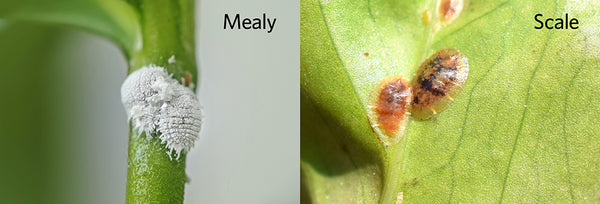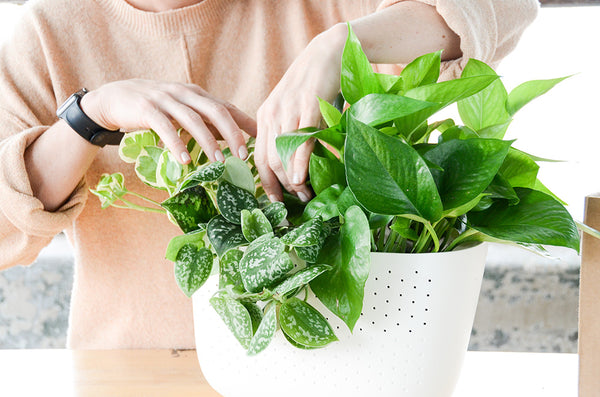
How To Get Rid Of Mealybug On Houseplants
Have you noticed persistent, white, fluffy-looking masses on your plants lately? Don’t brush it off thinking it’s fungus or mildew, because heads up, plant lovers; you’ve got a mealybug problem on your hands.
Symptoms
Let’s take a look at how you can spot these pests. Because these bugs are pretty visually evident, the best way is just to inspect the leaves and stems of your plant for white, cottony masses. Check the underside of leaves, in new leaf folds, and around the growing tips for signs of these pests. Unfortunately, they can hide in stem crevices, leaf whorls, and other tight spots that are hard to reach (even the roots themselves), making it hard to discover them until they’re everywhere. Be vigilant!

Mealybugs are small, soft-bodied insects that produce white, waxy, cottony material that helps protect them from heat and moisture loss and also repels water-based insecticides. They are related to scale insects, but you can distinguish them by their color - scale insects are brownish, and will stay in one place on the plant. Female mealybugs are visible to the naked eye and can lay eggs without mating, laying hundreds of eggs over several days, then dying soon after. The eggs look like fuzzy white masses and hatch in about 10 days, producing ‘nymphs’ or ‘crawlers’ that then relocate to find a feeding spot & spend a couple months developing into adults from there.
Where do they come from? Mealybugs are common pests in warmer growing climates, greenhouses, and on indoor plants. They can be introduced on new plants, tools or pots, and can even ride along on people who have handled plants with mealybug on them.
Diagnosis
Mealybugs feed by sucking sap from their host plants, weakening them. As they feed, they form the waxy coating over their bodies and secrete honeydew that attracts ants and can encourage sooty mold to form. Over time, the damage causes leaves to yellow and drop off, and will cause new growth to become stunted and deformed. Their population is only noticeable once it gets large enough, and grows exponentially from there; if left unchecked, mealy can eventually kill a plant. Read on for methods to eliminate this fuzzy menace from your plants!
Prevention

The only good ways to prevent mealybug from occurring is to avoid putting your plants outside during the summer and make sure to thoroughly inspect any new plant babes, pots or tools you’re bringing home before bringing them inside. However, no matter how careful you are, there’s still a chance for your plants to become a mealy playground.
Treatments
1. PRUNE & ISOLATE
The first thing you should do when you discover mealy is to isolate the plant away from other plants. If there aren’t too many fuzzy spots, you can try to prune out problem areas, disposing of them immediately & carefully. Then, use one or more of the methods below to treat the rest of the plant. Remember to clean and disinfect the area that the plant was in before you moved it.
2. MANUAL REMOVAL
Soak a cotton swab or washcloth in rubbing alcohol and use that to wipe down the leaves and stems. Use a soaked q-tip to get into those small nooks and crannies. This will kill mealy on contact, but it only works if it touches them directly. Make sure to wipe around leaf joints, in folds, and at the base of the plant, too. You may also find them hiding around the edges of the pot. Repeat daily - it will take several treatments. Once you’re positive the bugs are all gone, rinse off the plant in the sink or shower to remove the rubbing alcohol. This method can also work with cotton swabs dipped in a mixture of diluted dish soap and water, but be careful, because concentrated dish soap can burn the leaves!
3. WASH THEM OUT
When you hose down your plant with water, the pressure will force the mealybugs to dislodge. Washing rarely eliminates 100% of the pests, so keep watch and wash periodically when more are noticed. If you don't have a hose, a handheld shower head on a high pressure setting will do the trick!

4. USE A SOAP SPRAY
Soap sprays are contact insecticides that must coat the the mealybugs & their eggs in order to break down the waxy white secretion and kill the insects beneath. Soap-based insecticides are non-toxic to humans and animals, but can harm the plant, so use a diluted solution.
Using an insecticidal soap meant for treating mealybug, follow the instructions on the label to make a diluted mixture using soft or distilled water (hard water can make it ineffective). Transfer your solution to a pump sprayer and spray the plant down well, making sure you get the top and underside of every leaf, the stems, and the base. Repeat with a fresh mixture every week until the bugs are gone. Pro Tip: Ideally, you should spray outside on a cloudy day when the temperature is below 90 degrees.
You can also make your own solution using dish soap, but it may not be as effective.
5. NEEM OIL
Neem oil is a natural insecticide and fungicide that is very effective for eliminating mealy bugs and even for residual pest control after they’re gone. Best of all, neem oil is non-toxic to beneficial bugs like honey bees, if your plants are outside. Dilute concentrated neem oil according to the instructions on the label, and apply with a spray bottle daily. Be patient, as it may take a few days of use to start to kill the bugs, and continue to reapply until they’re all gone! Alternatives to neem oil are hot pepper wax spray and other horticultural oil.
6. BUGS!
Pick up some beneficial bugs at your local garden center to help control the population. Ladybugs, lacewing and the Mealybug Destroyer beetle are all natural predators of the mealybug. This is an option most suited to plants growing outdoors or in greenhouses, but if you go this route, you can't use insecticides without killing the good bugs, too.
7. BE RELENTLESS
No matter which method or combinations of methods you use, be relentless in your fight! Don’t expect them to disappear after just one or just a few treatments. It may take weeks or even months of constant vigilance to end your mealybug woes. Even if you don’t see any on the plant, they are tiny, so they can’t really be seen unless there’s a lot of them; that, and they may emerge from crevices and hiding spots from the area around the plant just when you think they’re gone. If you’re dealing with a reoccurring infestation, try replacing the top layer of soil and cleaning around the pot - rim, sides, bottom, everything.
8. CONSIDER CUTTING YOUR LOSSES
No one wants to lose their favorite plants, but in cases of severe infestations, you might consider throwing out the worst of the bunch and starting anew after thoroughly cleaning the areas that the infested plants were in.
We hope these tips and tricks help you eradicate these fuzzy menaces once and for all! Good luck, plant fam!
